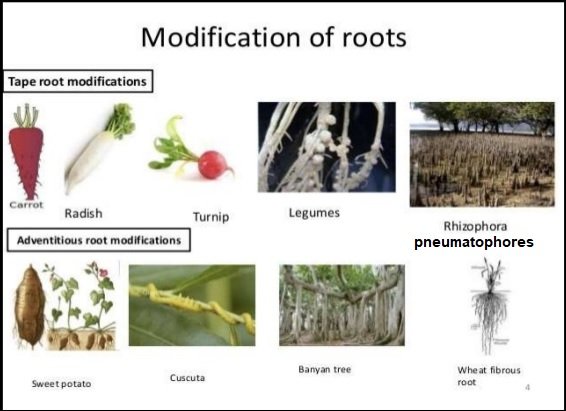Roots- Morphology of Flowering plants
Roots- Morphology of Flowering Plants
The term Morphology is derived from Greek words: morphe– forms and logos– study
Morphology is the branch of biological science that deals with the study of the form, size, shape, color, and external structure of organisms.
In flowering plants is large diversity is found in external structure or morphology these are mostly differentiated into the root system (underground) and shoot system (aerial).
The root system consists of roots and their branches while the shoot system consists of stems, branches, leaves, buds, flowers, and fruits.

Parts of flowering plant
The Root
The root is generally non-green, underground, hydrophytic, and positively geotropic. it is a negatively phototropic and descending cylindrical axis of a plant that develops from the radicle of the embryo.
These provide anchorage for the plant, taking in water and nutrients which help the plant to grow.
Structure of Roots
Generally, the roots of plants divided into three main regions
- Region of Maturation
- Region of Elongation
- Region of Meristematic Activity- A few millimeters above the root cap

structure of root
The root is covered at the apex by a thimble-like structure called the root cap. Its main function is to protect the tender apex of the root that makes its way through the soil. Region of meristematic activities found above root cap.
The region of elongation is found at the place where the newly formed cells increase in length and by this the lengthening or elongation or the root takes place.
from the region of maturation epidermal cells form very fine and delicate, thread-like structures called root hairs. These root hairs absorb water and minerals from the soil.
Type of root system
The main functions of the root system are the absorption of water and minerals from the soil, providing a proper anchorage to the plant parts, storing reserve food material, and synthesizing plant growth regulators.
- Formation of the primary root by the direct elongation of radicle in most dicotyledonous plants. It grows inside the soil. It bears lateral roots of several orders that are referred to as secondary, tertiary, etc. roots.
- The primary roots and their branches constitute the tap root system, as seen in the mustard plant.
- There are short-lived primary roots found in monocot plants, which are replaced by a large number of roots that originate from the base of the stem and constitute the fibrous root system, as seen in the wheat plant.
- The roots arise from parts of the plant other than the radicle and are called adventitious roots. In some plants, like grass, Monstera, and the banyan tree.
Modifications of Roots
| S.No | Modification of root | Functions | Example |
| 1 |
Modification of Tap Root |
||
| I | Conical | root base is broad, tapering apex and fleshy basal part is shown
Storage of food |
Carrot (Daucus carota) |
| II | Fusiform | The middle part is swollen, tapering apex, secondary root arises from the apical region.
Storage of food |
Radish (Raphanus sativus) |
| III | Napiform | The base found thick, root suddenly tapers towards the apex
Storage of food |
Turnip (Brassica rapa) |
| IV | Tuberous | Tuber like, no definite shape or size
Storage of food |
Mirabilis |
| V | Nodulated (tuberculated) | Nodules on primary secondary roots . Atmospheric N2 fixation ability. | Pea (peasum sativum) |
| VI | Respiratory roots (Pneumatophores) | Functions to gas exchange in aerobic respiration. | Mangrove plants (sonneratia and Avicenia, Rhizophora) |
| 2 |
Modification of Adventitious Roots |
||
| I
|
Fasciculate | Store food | Dahlia and Asparagus |
| II | Moniliform | Store food | Portulaca and Momordica |
| III | Annulated | Medicinal value | Ipecac (cephaelis) |
| IV | Palmate | Medicinal value | Orchid |
| V | Reproductive | Vegetative propagation | Sweet potato and Dahlia |
| 3 |
Modification of Root For Mechanical Support |
||
| I | Prop root | Arises from nodules of main stems grow vertically downward the soil and anchor. Functions as Mechanical support. | Banyan tree (Ficus benghalensis), rubber plant
|
| II | Stilt root | Arises from the stem, enters in soils, consisting of many root caps.
Functions for aditional support, absorption of water and minerals from the soil |
Pandanus, Sorghum, Maize |
| III | Clinging Roots | Arises from nodes and internodes in week stemmed plants these observed in epiphytes or space parasites
Function for climbing, additional support |
Piper betel and pothos |
| Iv | Buttress roots | These are large wide roots that arise from the basal part of the stem, spreads in the soil in various directions.
Works for support |
Almond and peepal |
You can also read:




8 Comments
Stem- Morphology of flowering plants - PCSSTUDIES - Biology · April 24, 2021 at 11:51 pm
[…] root system (morphology of root) […]
Morphology of Leaf - Biology - PCSSTUDIES Morphology of Leaf - % · May 3, 2021 at 4:06 pm
[…] root system (morphology of root) […]
Inflorescence in flowers - Biology - PCSSTUDIES % · May 7, 2021 at 8:00 pm
[…] Morphology of roots […]
The Flower - PCSSTUDIES - Biology - Morphology of flowering plant - · May 12, 2021 at 7:16 pm
[…] Morphology of roots […]
Reproduction in Organisms - PCSSTUDIES - Biology · November 24, 2021 at 3:51 pm
[…] Morphology of roots […]
Sexual Reproduction in Flowering Plants - PCSSTUDIES Biology · June 14, 2022 at 6:30 pm
[…] Morphology of roots […]
Floral Diagram and formula - PCSSTUDIES - Biology · June 24, 2022 at 12:52 pm
[…] Morphology of roots […]
Transport in Plants - PCSSTUDIES Botany · May 27, 2023 at 9:43 am
[…] Morphology of roots […]